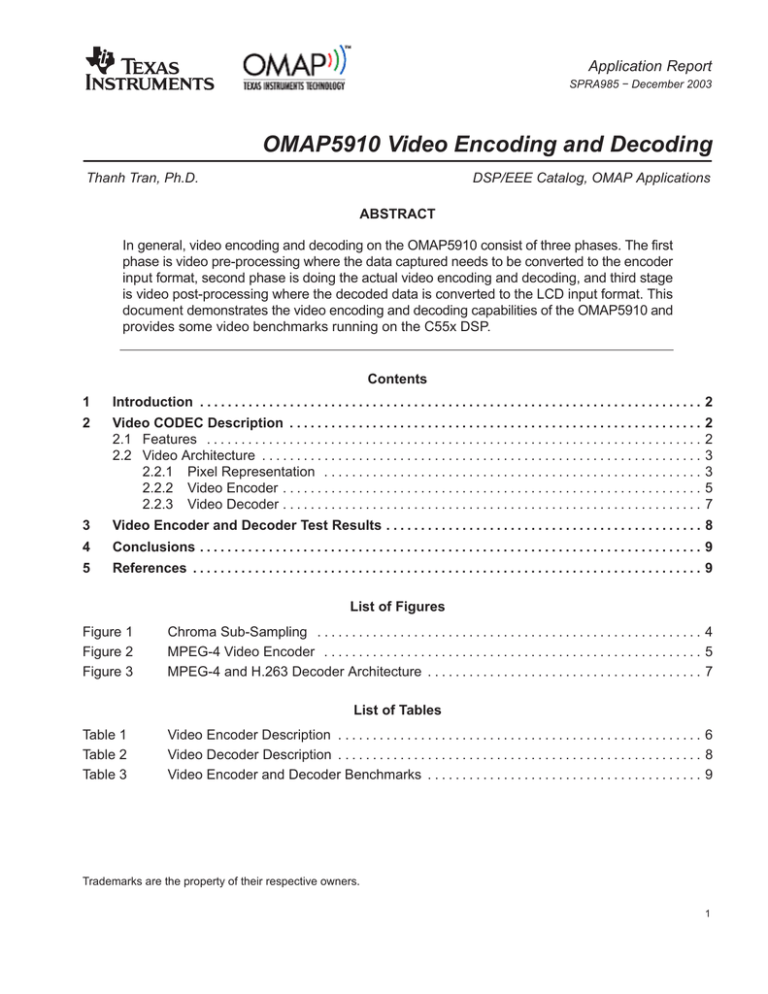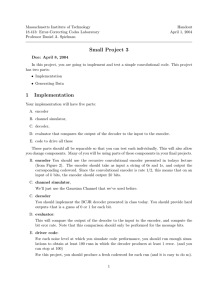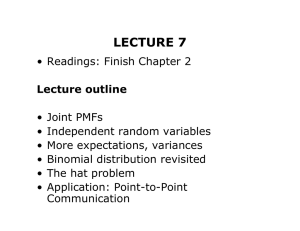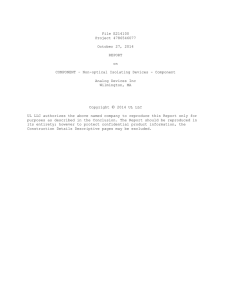OMAP5910 Video Encoding and Decoding
advertisement

Application Report SPRA985 − December 2003 OMAP5910 Video Encoding and Decoding Thanh Tran, Ph.D. DSP/EEE Catalog, OMAP Applications ABSTRACT In general, video encoding and decoding on the OMAP5910 consist of three phases. The first phase is video pre-processing where the data captured needs to be converted to the encoder input format, second phase is doing the actual video encoding and decoding, and third stage is video post-processing where the decoded data is converted to the LCD input format. This document demonstrates the video encoding and decoding capabilities of the OMAP5910 and provides some video benchmarks running on the C55x DSP. Contents 1 Introduction . . . . . . . . . . . . . . . . . . . . . . . . . . . . . . . . . . . . . . . . . . . . . . . . . . . . . . . . . . . . . . . . . . . . . . . . . 2 2 Video CODEC Description . . . . . . . . . . . . . . . . . . . . . . . . . . . . . . . . . . . . . . . . . . . . . . . . . . . . . . . . . . . . 2.1 Features . . . . . . . . . . . . . . . . . . . . . . . . . . . . . . . . . . . . . . . . . . . . . . . . . . . . . . . . . . . . . . . . . . . . . . . . 2.2 Video Architecture . . . . . . . . . . . . . . . . . . . . . . . . . . . . . . . . . . . . . . . . . . . . . . . . . . . . . . . . . . . . . . . . 2.2.1 Pixel Representation . . . . . . . . . . . . . . . . . . . . . . . . . . . . . . . . . . . . . . . . . . . . . . . . . . . . . . . 2.2.2 Video Encoder . . . . . . . . . . . . . . . . . . . . . . . . . . . . . . . . . . . . . . . . . . . . . . . . . . . . . . . . . . . . . 2.2.3 Video Decoder . . . . . . . . . . . . . . . . . . . . . . . . . . . . . . . . . . . . . . . . . . . . . . . . . . . . . . . . . . . . . 3 Video Encoder and Decoder Test Results . . . . . . . . . . . . . . . . . . . . . . . . . . . . . . . . . . . . . . . . . . . . . . 8 4 Conclusions . . . . . . . . . . . . . . . . . . . . . . . . . . . . . . . . . . . . . . . . . . . . . . . . . . . . . . . . . . . . . . . . . . . . . . . . . 9 5 References . . . . . . . . . . . . . . . . . . . . . . . . . . . . . . . . . . . . . . . . . . . . . . . . . . . . . . . . . . . . . . . . . . . . . . . . . . 9 2 2 3 3 5 7 List of Figures Figure 1 Figure 2 Figure 3 Chroma Sub-Sampling . . . . . . . . . . . . . . . . . . . . . . . . . . . . . . . . . . . . . . . . . . . . . . . . . . . . . . . . 4 MPEG-4 Video Encoder . . . . . . . . . . . . . . . . . . . . . . . . . . . . . . . . . . . . . . . . . . . . . . . . . . . . . . . 5 MPEG-4 and H.263 Decoder Architecture . . . . . . . . . . . . . . . . . . . . . . . . . . . . . . . . . . . . . . . . 7 List of Tables Table 1 Table 2 Table 3 Video Encoder Description . . . . . . . . . . . . . . . . . . . . . . . . . . . . . . . . . . . . . . . . . . . . . . . . . . . . . 6 Video Decoder Description . . . . . . . . . . . . . . . . . . . . . . . . . . . . . . . . . . . . . . . . . . . . . . . . . . . . . 8 Video Encoder and Decoder Benchmarks . . . . . . . . . . . . . . . . . . . . . . . . . . . . . . . . . . . . . . . . 9 Trademarks are the property of their respective owners. 1 SPRA985 1 Introduction This application note is intended to show an implementation example of the wireless video codec (encoder and decoder) that includes pre-processing of the captured data to interface with the encoder and post-processing of the data to interface with the LCD panel. The video codec is compliant with the low bit rate codec for multimedia telephony defined by the Third Generation Partnership Project (3GPP) in the specifications, 3G TS 26.110, 3G TS26.111 and Recommendation 3G TR 26.911. The baseline CODEC defined by 3GPP is H.263 and MPEG-4 Simple Visual Profile is defined as an optional. The video codec implemented supports the following video formats. 2 • SQCIF or 128 x 96 resolution • QCIF or 176 x 144 resolution at Simple Profile Level 1 • CIF or 352 x 288 resolution at Simple Profile Level 2 • 64 kbits/s for Simple Profile Level 1 • 128 kbits/s for Simple Profile Level 2 Video CODEC Description The video encoder implemented requires a YUV 4:2:0 non-interface video input and, therefore, pre-processing of the video input may be required depending on the application. For the video decoder, post-processing is needed to convert the decoded YUV 4:2:0 data to RGB for displaying. 2.1 Features • Pre-processing: − • 2 YUV 4:2:2 interlaced (from camera for example) to YUV 4:2:0 non-interlaced, only decimation and no filtering of the UV components. Post-processing: − YUV 4:2:0 to RGB conversion − Display formats of 16 bits or 12 bits RGB − 0 to 90 degrees rotation for landscape and portrait displays • MPEG-4 Simple Profile Level 0, Level 1 and Level 2 support • H.263 and MPEG-4 decoder and encoder compliant • MPEG-4 video decoder options are: − AC/DC prediction − Reversible Variable Length Coding (RVLC) − Resynchronization Marker (RM) − Data Partitioning (DP) − Error concealment, proprietary techniques OMAP5910 Video Encoding and Decoding SPRA985 • 2.2 2.2.1 − 4 Motion Vectors per Macroblock (4MV) − Unrestricted Motion Compensation − Decode VOS layers MPEG-4 video encoder options are: − Reversible Variable Length Coding (RVLC) − Resynchronization Marker (RM) − Data Partitioning (DP) − 4 Motion Vectors per Macroblock (4MV) − Header Extension Codes − Bit rate target change during encoding − Coding frame rate change during encoding − Insertion or not of Visual Object Sequence start code • Insertion of I-frame during the encoding of a sequence support • Encoder Adaptive Intra Refresh (AIR) support • Multi-codec support, multiple codecs running from the same code Video Architecture Pixel Representation Red, Green and Blue or RGB are the primary colors for the computer display and the color depth supported by the OMAP5910 is programmable up to 16 bits per pixel, RGB565 (5 bits for Red, 6 bits for Green and 5 bits for Blue). In the consumer video such as DVD, camera, digital TV and others, the common color coding scheme is YCbCr where Y is the luminance, Cb is the blue chrominance and Cr is the red chrominance. Human eyes are much more sensitive to the Y component of the video and this enables video sub-sampling to reduce the chrominance component without being detected by the human eyes. This method is referred to as YCbCr 4:2:0, YCbCr 4:2:2 or YCbCr 4:4:4. Figure 1 shows the sub-sampling techniques applied to the video. OMAP5910 Video Encoding and Decoding 3 SPRA985 4:2:0 format 4:2:0 S Two chroma per four luma: YYYYCbCr S Odd lines only S Most common format used in: portable video (MPEG-4) and video conferencing (H.263) 4:2:2 format Luma Sample (Y) Chroma Sample (Cr,Cb) 4:2:2 S Four chroma per four luma: YYYYCbCrCbCr S Most common format used in: DVD, digital TV, HDTV, and other consumer video devices 4:4:4 format 4:4:4 S Full pixel representation: YYYYCbCrCbCrCbCrCbCr S Used in high-quality video applications, studios, and professional videos Luma Sample (Y) Chroma Sample (Cr,Cb) Figure 1. Chroma Sub-Sampling In the OMAP5910 design, for the decoded video to be displayed, post-processing is needed to calculate the RGB values equivalent of the YCbCr data. The post-processing engine computes the following equations to obtain the gamma-corrected RGB information. • R = Y + 1.371(Cr – 128) • G = Y – 0.698(Cr – 128) – 0.336(Cb – 128) • B = Y + 1.732(Cb – 128) Refer to the NDA only specification of the test code implemented to demonstrate the pre-processing and post-processing for MPEG-4 encoder and decoder. 4 OMAP5910 Video Encoding and Decoding SPRA985 2.2.2 Video Encoder Figure 2 shows a simplified block diagram of the video encoder ported to the OMAP5910. See Table 1 for a brief description of the individual block. Rate Cont. Video Buffer + + DCT Q _ IQ PreProc. VLC Buffer IDCT Output Input + MC Frame Buffer ME Figure 2. MPEG-4 Video Encoder OMAP5910 Video Encoding and Decoding 5 SPRA985 Table 1. Video Encoder Description Block Name Block Description Block Function Pre-Proc. Pre-Processing If necessary, the Pre-Proc. Block converts the input video format to YUV 4:2:0. Video Buffer Video Buffer Encoder stores the compressed data for processing. DCT Discrete Cosine Transform DCT transformation decomposes each input block into a series of waveforms with a specific spatial frequency. Outputs an 8x8 block of horizontal and vertical frequency coefficients. Q Quantization Quantization block uses the psychovisual characteristics to eliminate the unimportant DCT coefficients, high frequency coefficients. IQ Inverse Quantization IQ computes the inverse quantization matrix by multiplying the quantized DCT with the quantization table. IDCT Inverse Discrete Cosine Transform IDCT computes the original input block. Errors are expected due to quantization. Frame Buffer Frame Buffer Memory required for video processing, typically 3 frames stored. ME Motion Estimation ME uses a scheme with fewer search locations and fewer pixels to generate motion vectors indicating the directions of the moving images. MC Motion Compensation MC block increases the compression ratio by removing the redundancies between frames. VLC Variable Length Coding Lossless VLC coding reduces the bit rate by sending shorter codes for common pairs (number of zeros and number of non-zeros) and longer codes for less common pairs. Rate Cont. Rate Control Control the bit rate by changing the quantization rules, for example using fewer bits per DCT coefficient. Buffer Buffer Output data buffer Refer to the NDA only specification of the MPEG-4/H.263 encoder code example implemented by TI to demonstrate the video capabilities of the OMAP5910. 6 OMAP5910 Video Encoding and Decoding SPRA985 2.2.3 Video Decoder The video decoder shown in Figure 3 is MPEG-4 and H.263 compliant. The decoder is capable of decoding both H.263 and MPEG-4 bitstreams and is automatically detecting the header to determine which decoding method (H.263 or MPEG-4) to use. The shaded blocks are common for both decoders. See Table 2 for a brief description of the individual block. Decoder Getpicture() MPEG4 RM only H263 Error concealment GetH263GOB() VlcGetBlock() VlcdecTCOFF() MPEG4 DP GetPacket() VLD RVLD GetPacketDataPartition() VlcGetBlock() RvlcdecTCOFF() concealIntraframe() concealInterframe() ACDC IQ IDCT MC DoDcAcInversePred() ... InverseQuant() idct() addblock() Figure 3. MPEG-4 and H.263 Decoder Architecture OMAP5910 Video Encoding and Decoding 7 SPRA985 Table 2. Video Decoder Description Block Name Block Description Block Function Decoder Decoder Determines the bitstream (MPEG-4 or H.263) H263 H.263 Gets the H.263 stream and inputs it to the appropriate module. MPEG4 RM Only MPEG-4 Resynchronization Video stream with synchronization marker embedded. Marker Only MPEG4 DP MPEG-4 Data Partitioning Video stream with data partitioned ACDC AC and DC Coefficients of the DCT table For MPEG-4 decoder only, predicts the AC coefficients. RVLD Reversible Variable Length Decoding For MPEG-4 decoder only, allows for RVLD when the bitstream is coded using Reversible Variable Length techniques. VLD Variable Length Decode For both H.263 and MPEG-4 decoders, IQ Inverse Quantization IQ computes the inverse quantization matrix by multiplying the quantized DCT with the quantization table. IDCT Inverse Discrete Cosine Transform IDCT computes the original input block. Errors are expected due to quantization. MC Motion Compensation MC block increases the compression ratio by removing the redundancies between frames. Error Concealment Error Concealment Proprietary error concealment techniques developed by TI. Refer to the NDA only specification of the MPEG-4/H.263 decoder code example implemented by TI to demonstrate the video capabilities of the OMAP5910. 3 Video Encoder and Decoder Test Results The decoder tests were conducted using the following sequences. − Akiyo − Claire − Foreman − Mother and Daughter − Carphone The performance was measured on the OMAP5910 using Code Composer Studio 2.1 profiling tools. The performance data does not include the latency associated with memory-to-memory transfer. 8 OMAP5910 Video Encoding and Decoding SPRA985 The encoder tests were conducted using the following sequences. − Akiyo − Foreman − Coastguard The performance was measured on the C5510 using Code Composer Studio 2.0 profiling tools. The results do include the memory-to-memory transfer in the encoder test case. Table 3. Video Encoder and Decoder Benchmarks Video Format Video Encoder Video Decoder H.263 / QCIF @ 15 fps @ 64 kbps 23 Mcycles/s (test on C5510) 9.6 Mcycles/s (test on OMAP5910) H.263 / QCIF @ 15 fps @ 64 kbps (includes DMA overhead) QCIF @ 30 fps (MPEG-4 SP @ Level 1) CIF @ 30 fps (MPEG-4 SP @ Level 3) 4 12.9 Mcycles/s (test on OMAP5910) 46 Mcycles/s (test on C5510) 24 Mcycles/s (test on C5510) 96 Mcycles/s (test on C5510) Conclusions This application note demonstrates the video encoding and decoding capabilities of the OMAP5910. The codec code examples used to profile the system and detailed CODEC specifications are proprietary information to TI and are only available to OMAP customers under non-disclosure agreement (NDA). Since OMAP5910 consists of ARM925 general-purpose processor and the C55x DSP, some of the benchmarks tested on the C5510 DSP should be similar when running the same tests on the OMAP5910 platform. 5 References 1. OMAP5910 Dual-Core Processor Data Manual (SPRS197) 2. OMAP5910 Dual-Core Processor Functional and Peripheral Overview Reference Guide (SPRU602) 3. OMAP Algorithm: Wireless Video CODEC Implementation on C55xx, TI internal proprietary document, Version 7.3, October 2003. 4. Image Pre-Processing & Post-Processing Libraries, TI internal proprietary document OMAP3A019, Version 0.1, December 2001. OMAP5910 Video Encoding and Decoding 9 IMPORTANT NOTICE Texas Instruments Incorporated and its subsidiaries (TI) reserve the right to make corrections, modifications, enhancements, improvements, and other changes to its products and services at any time and to discontinue any product or service without notice. Customers should obtain the latest relevant information before placing orders and should verify that such information is current and complete. All products are sold subject to TI’s terms and conditions of sale supplied at the time of order acknowledgment. TI warrants performance of its hardware products to the specifications applicable at the time of sale in accordance with TI’s standard warranty. Testing and other quality control techniques are used to the extent TI deems necessary to support this warranty. Except where mandated by government requirements, testing of all parameters of each product is not necessarily performed. TI assumes no liability for applications assistance or customer product design. Customers are responsible for their products and applications using TI components. To minimize the risks associated with customer products and applications, customers should provide adequate design and operating safeguards. TI does not warrant or represent that any license, either express or implied, is granted under any TI patent right, copyright, mask work right, or other TI intellectual property right relating to any combination, machine, or process in which TI products or services are used. Information published by TI regarding third-party products or services does not constitute a license from TI to use such products or services or a warranty or endorsement thereof. Use of such information may require a license from a third party under the patents or other intellectual property of the third party, or a license from TI under the patents or other intellectual property of TI. Reproduction of information in TI data books or data sheets is permissible only if reproduction is without alteration and is accompanied by all associated warranties, conditions, limitations, and notices. Reproduction of this information with alteration is an unfair and deceptive business practice. TI is not responsible or liable for such altered documentation. Resale of TI products or services with statements different from or beyond the parameters stated by TI for that product or service voids all express and any implied warranties for the associated TI product or service and is an unfair and deceptive business practice. TI is not responsible or liable for any such statements. Following are URLs where you can obtain information on other Texas Instruments products and application solutions: Products Amplifiers Applications amplifier.ti.com Audio www.ti.com/audio Data Converters dataconverter.ti.com Automotive www.ti.com/automotive DSP dsp.ti.com Broadband www.ti.com/broadband Interface interface.ti.com Digital Control www.ti.com/digitalcontrol Logic logic.ti.com Military www.ti.com/military Power Mgmt power.ti.com Optical Networking www.ti.com/opticalnetwork Microcontrollers microcontroller.ti.com Security www.ti.com/security Telephony www.ti.com/telephony Video & Imaging www.ti.com/video Wireless www.ti.com/wireless Mailing Address: Texas Instruments Post Office Box 655303 Dallas, Texas 75265 Copyright 2003, Texas Instruments Incorporated







